|
"This division (of
arrow point forms) includes all
arrowpoints or spearheads in the form of a triangle, whether the bases
or edges be straight, convex, or concave."------1897,
Thomas Wilson, "Arrowpoints, Spearheads, And Knives Of Prehistoric
Times," Annual Report Of The Board Of Regents Of The Smithsonian
Institution, p. 909.
"The shape of the stone arrowhead among the
Indian tribes is usually triangular or pointed-oval, though some have
very slender blades with expanding base."---------1912,
Frederick Webb Hodge, "Arrowheads," Handbook Of American Indians
North Of Mexico, part 1, p. 90.
"Those (arrowheads)
without notches were secured by the cord passing over and under the
angle at the base in a figure-8 fashion."--------1912,
Frederick Webb Hodge, "Arrowheads," Handbook Of American Indians
North Of Mexico, part 1, p. 90.
"The
earliest direct evidence (of the bow
and arrow) comes in the form of arrow
shafts from Stellmoor (West Germany)
10,500 years ago."----1988,
Tattersall, Ian, Delson, Eric & Couvering, John Van, "Encyclopedia Of
Human Evolution And Prehistory," p. 97.
"Anthropologists in South Africa say they've discovered
64,000 year old stone points that are the earliest direct evidence of
human-crafted arrows."----2010,
UPI, (United Press International), "Oldest Arrowheads Found In
Africa."
"The
world which we know would not exist without fire and the wheel and
perhaps the same may hold true of the bow."----1957,
Edmund Burke, "The History Of Archery," p. 9.

TRIANGULAR ARROW POINTS
7,000 B.C. TO A.D. 1700
WORLDWIDE
The bow and arrow represents one of the great
technological advancements in weaponry in the ancient world. In fact,
the bow is the first mechanical device that could store energy, as the
arrow was held in the string before its release. Recent distance records
in flight archery for pulled bows are around one third mile, the
longest crossbow shot is 1.16 miles! Bows and arrows were used just about everywhere in
the world except Australia
where spear throwers were the preferred weapon. Triangular
shaped arrow points were one of the most common types of arrow points
used on the tips of arrows. |
|
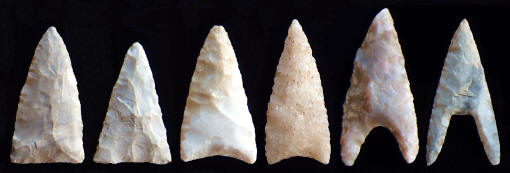
CLICK ON PICTURE FOR LARGER IMAGE
SIX DIFFERENT COUNTRIES
TRIANGULAR ARROW POINTS
UNITED STATES, SAUDI ARABIA,
SWITZERLAND,
PERU, AFRICA & NORTHERN EUROPE
These six points illustrate how
universal the triangular shape is. They were found on widely separated
locations around the world. Some of them are separated in time by
thousands of years.
The point on the left was found on a Mississippian site
in southern Illinois and dates to sometime between 850 and 1400.
It's made from light gray Burlington chert and measures 31/32 of an
inch (2.4 cm) long.
The second point from the left was found on a site in
Saudi Arabia by a geologist. It could date to sometime between 5,000
and 7,000 years ago. This point measures 15/16 of an inch (2.3 cm)
long.
The third point from the left was found on
the Auvernier site in western Switzerland.
It could date to sometime between 4,000
and 6,000 years ago. It's
made from good quality yellow and gray chert and measures 1 1/16
inches (2.6 cm) long.
The fourth point from the left was collected on a site
on the west coast of Peru. It's made of semi-translucent brownish
colored quartz.
The fifth point from the left was collected on a
Neolithic site in one of the countries in the Sub-Saharan desert
region of Africa, possibly Niger. It probably dates to
sometime between 5,000 and 7,000
years ago. It's made of a good quality gray and purple chert and
measures 1 3/16 inches (3 cm) long.
The point on the right was collected on a site in
northern Europe, possibly Denmark. It's a very thin and skillfully
flaked point. It's the nicest point in this group. It dates to
sometime during the late Neolithic to Early Bronze Age around 3,500
to 4,000 years ago. It's made of bluish gray Danish flint and
measures 1 1/8 inches (2.9 cm) long. |
|
|
In 1897 Thomas Wilson defined the division of
triangular arrow points as, "all arrowpoints or spearheads in the form
of a triangle, whether the bases or edges be straight, convex, or
concave." These are points that have no basal stems or side &
corner notches. But they
may have straight, concave or convex bases and sides. They may also have
smooth or serrated blade edges. |
|
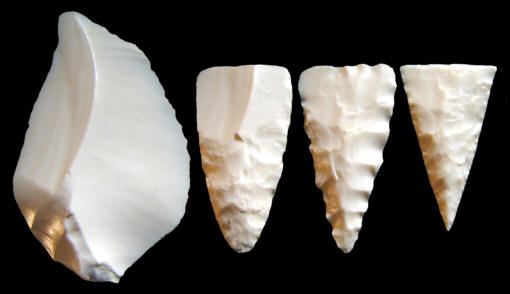
CLICK ON PICTURE FOR LARGER IMAGE
STAGES OF MANUFACTURE OF
A TRIANGULAR ARROW POINT
BY DAVE KLOSTERMEIER
This picture shows the manufacturing stages of a finely crafted
bifacially flaked triangular arrow point. It was made with either a
copper or antler pressure flaking tool. These are actually casts
that were made of the same point, at different stages of its
development. It was made sometime in the 1980's by Dave Klostermeier.
The cast on the left shows how the original flake looked before it
was made into a triangular arrow point. The next two show the
initial shaping and reduction stages. Some of the flakes are larger
and portions of the original surface of the flake can still be seen.
The finished point on the right is uniformly shaped and all of the
edges have been carefully trimmed and straightened. |
|
|
Triangular arrow points were simple, efficient and easy to
make. They could be made from an edge trimmed flake in five minutes or
bifacially flaked into a more refined and uniformly shaped point. They
were manufactured with the use of pressure flaking tools made of antler, bone, copper or even
from such materials as porcupine teeth. |
|

TRIANGULAR CHOCTAW ARROW
POINT
RECOVERED FROM BACK LEG OF
CHICKASAW
MISSISSIPPI
This picture shows three views of an
arrow point that was excavated on a Chickasaw village site sometime
in the 1990's by John O'Hear, Cobb Institute Of Archaeology,
Mississippi State University. It was repatriated and reburied by the
tribe in 1997. The site was dated to between 1680 and 1720. This
point is most interesting for the fact that it was recovered from
the back of the right knee of a 20-25 year old male who had also
been shot in the upper chest. But since this yellow type of chert
originates from a source located well to the south of the Chickasaw
area, it's believed that the point is Choctaw in origin and as John
O'Hear strongly suspected, "this guy "bought it" on a raid." |
|
|
Admiral
Sir Edward Belcher (1799-1877) at Icy Cape, Alaska described an Eskimo's
process of making an arrow point as: "Selecting a log of wood in which a
spoon-shaped cavity was cut, they placed the splinter (flake)
to be worked over it, and by pressing gently along the margin
vertically, first on one side, then on the other, as one would set a
saw, they splintered off alternate fragments until the object thus
properly outlined presented the spear or arrowhead form, with two
cutting serrated edges." He describes the pressure flaking tool as a
handle made of fossil ivory that had a small piece of deer antler
mounted on the end. |
|
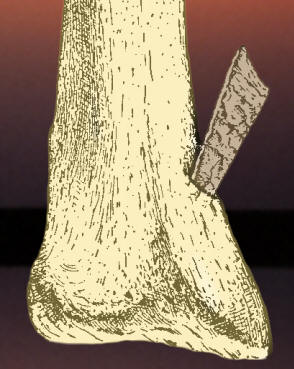
Image from 1997 "Annual Report Of
The Board Of Regents Of The Smithsonian Institution.
"Arrowpoints, Spearheads, And Knives Of Prehistoric Times"
ARROW POINT
EMBEDDED IN HUMAN TIBIA
FRANCE
Triangular
arrow points were used for hunting, and from the excavation of
burials on ancient sites around the world, they were also used as
weapons. This drawing shows a stone arrow points that is solidly
embedded into a human tibia. It was excavated on a site in France. |
|
|
Triangular arrow points have been in use for at least
9,000 years. In the eastern United States they were being made by
different tribes as recently as the early 1700's. The earliest date for the direct
evidence of arrows comes from a discovery of arrow shafts from western
Germany that date to sometime around 10,500 years ago. But the earliest bow and arrow may
date tens of thousands of years earlier, if Anthropologists in South
Africa are correct in their estimate of 64,000 year old points they
believe were once attached to arrows. |
|
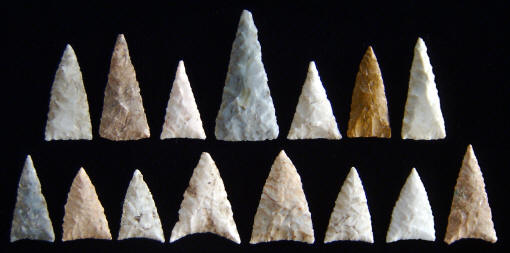
CLICK ON PICTURE FOR LARGER IMAGE
CACHE OF TRIANGULAR
MADISON POINTS
CAHOKIA MOUNDS SITE
ST. CLAIR & MADISON COUNTIES,
ILLINOIS
This group of triangular arrow points
were found several years ago by Bob Simons on the Ed Rouch farm on
the Cahokia Mounds site in southern Illinois. He found them within a
small area while surface collecting in a cultivated field. It's
believed they were a cache of points that may or may not have been
attached to arrows. |
|
|
Triangular arrow points have been found just about
everywhere in the world that stone arrow points were used. They are
found in Japan on Jomon Period sites as early as 9,000 years ago. In the
eastern United States they are found on post Mississippian sites as
late as the 1700's. They are found on Neolithic sites in the Sub-Sahara
Desert region of Africa as early as 7,000 years ago and 6,000 years ago
on Switzerland's Middle Neolithic lake sites, just to name a few. |
|
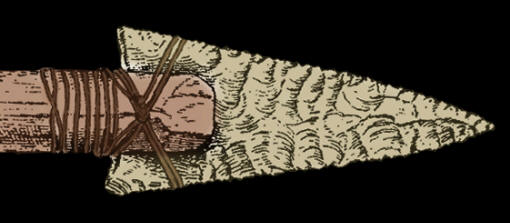
Image from 1997 "Annual
Report Of The Board Of Regents Of The Smithsonian Institution.
"Arrowpoints, Spearheads, And Knives Of Prehistoric Times"
DRAWING OF HAFTING TECHNIQUE
OF A TRIANGULAR ARROW POINT
This drawing illustrates how a
triangular arrow point might be hafted onto an arrow shaft. The end of
the shaft is notched to hold the point then wrapped with sinew or
other types of animal or vegetable materials. Arrow points could
also be held in place with the use of different types of tree resins or even
asphaltum. |
|
|
Triangular arrow points are the basic template from which most types of
arrow points were made. Triangular arrow points can be notched on the
sides or notched on the sides and the base, making them into double or
triple-notched points. They can also be notched on the basal corners to
form corner-notched points and even further shaped to have stems that
could be pressed into the soft core cellular tissue of some types of
arrow shafts. |
|
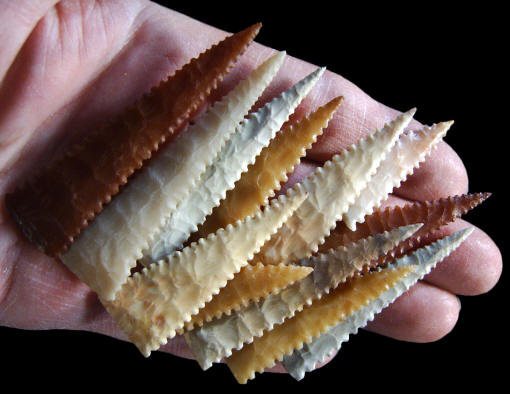
CLICK ON PICTURE FOR LARGER IMAGE
SERRATED TRIANGULAR ARROW
POINTS
CAHOKIA MOUNDS SITE
ST. CLAIR COUNTY,
ILLINOIS
This picture shows
a handful of some of the better examples of serrated triangular
arrow points that were found during the excavation of Mound 72 on
the Cahokia Mounds site in southern Illinois. They represent a small
sample of approximately 1200 arrow points of several different types
that were found. |
|
|
We don't
know when the first bow shot the first arrow. But we do know the archery
tradition is still alive and well in some areas of the world where
indigenous tribesmen still use them just as they did thousands of years
ago. As recently as February 8, 2006 on an island off the coast of India
two fishermen were shot with arrows and killed by Sentinelese tribesmen.
"One of the world's last Stone Age tribes has murdered two fishermen
whose boat drifted on to a desert island in the Indian Ocean." Another
example can be found in Papua New Guinea on June 19, 2011 when a New
Zealand man was shot twice by a local tribesman and survived. "The arrow
went into his right lung and the other through his ribs, under his liver
and through his stomach, stopping short of the aorta." So there still
are places in the world today where primitive technologies like the bow
and arrow are used just as they always have been, for hunting and for
weapons. |
|
"REFERENCES"
1897, Wilson, Thomas, "Arrowpoints, Spearheads, And Knives Of
Prehistoric Times," Annual Report Of The Board Of Regents Of The Smithsonian
Institution, p. 909-913 & 986.
1905, Fletcher, Alice C. & Flesche, Francis La, "The Omaha Tribe,"
Twenty-Seventh Annual Report Of The Bureau Of American Ethnology To
The Secetary Of The Smithsonian Institution, plate 40.
1912, Frederick Webb Hodge, "Handbook American Indians North Of
Mexico," p. 90.
1957, Edmund Burke, "The History Of Archery," p. 9.
1982, Aikens, C. Melvin, Higuchi, Takayasu, "The Jomon Period,"
Prehistory Of Japan, pp. 114-120.
1988, Tattersall, Ian, Delson, Eric & Couvering, John Van,
"Encyclopedia Of Human Evolution And Prehistory," p. 97.
1997, Personal Communication with John W. O'Hear
2010, UPI, (United Press International), "Oldest Arrowheads Found In
Africa."
|
|
RECENT
LISTINGS HOME
ORDERING |